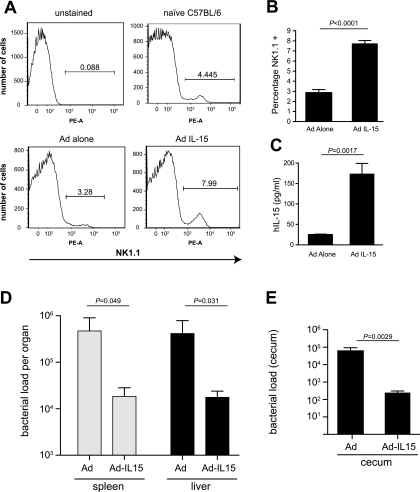FIG. 4.
Delivery of a recombinant adenovirus expressing IL-15 enhances mucosal and systemic innate defense against colonization by serovar Typhimurium. C57BL/6 mice were administered 5 × 108 PFU of adenovirus (Ad) alone,or recombinant adenovirus expressing human IL-15 (Ad IL-15) via intravenous tail vein injection as described in Materials and Methods. Mice were challenged with serovar Typhimurium and then sacrificed on day 2 postinfection. (A) FACS analysis of splenocytes isolated from naive mice or mice receiving injections of either Ad or Ad IL-15 and stained for the NK-cell marker NK1.1. (B) Average percentages of NK1.1+ populations in Ad alone-treated and Ad-IL-15-treated mice (five mice per group) were calculated from FACS data (P < 0.0001 for NK1.1+ cells from Ad-alone-treated mice versus those from mice receiving Ad-IL-15). (C) Serum from mice treated with Ad alone or with Ad -L-15 was analyzed by ELISA for human IL-15 (hIL-15). Data shown are the means with standard errors from five mice per group (P = 0.0017). (D) Bacterial load in the spleen and liver from mice pretreated with either Ad or Ad-IL-15 prior to infection with serovar Typhimurium (n = 5 per group). Data are mean with standard errors from five mice per group (Ad alone versus Ad-IL-15: spleen, P = 0.049; liver, P = 0.031). (E) Bacterial load in the cecum from mice pretreated with either Ad or Ad-IL-15 prior to infection with serovar Typhimurium (n = 5 per group). Data are means with standard errors from five mice per group (Ad alone versus Ad-IL-15: P = 0.0029).

